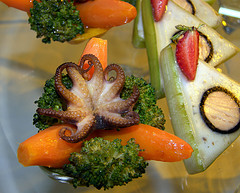Discovering the subtleties beneath the skin of an everyday superfood
Red and good
Discovering the subtleties beneath the skin of an everyday superfood.
TOMATOES are hailed as the new supeffood, able not just to combat cancer and cut cholesterol but also, it was revealed, to help keep skin youthful and protect against sunburn.
Although the health benefits of tomatoes are well established, the average Briton eats only 6kg of them a year, compared to the 36kg devoured by Italians.
The Brits are not known for adventurousness when it comes to tomatoes. I thought
that there were only four kinds round, plum, cherry, and the ones that come chopped in a can. So I'm astonished to find that there are more than 5,000 varieties in the world, and 5CI0 in Italy alone.
I have come to Italy to learn the ave of eating them from Paolo Battistel, a consultant
who is being vaunted as Britain's first "tommelier".
Growing up on a farm near Venice, tommelier Battiste[ learnt about tomatoes from his
maternal grandmother Maria, a formidable woman who grew them as a hobby. Every year she was determined to produce not only the earliest crop in their village but also the
biggest tomato.
Little Paolo began helping her from the age of four, and now, at 48, he is trouble shooting all over the globe and running specialist courses on cultivation at his tomato school near Lake Garda.
Like the grapes that go into wine, different tomatoes thrive in different types of soil and
with varying levels of sunlight.
"Like most Italians, I prefer tomatoes t6be green and acidic, but the British love them
sweet and red."
Today's four candidates all come from Sicily, which is known for pmducing some of
Italy's best tomatoes the harsh growing conditions and high salinity of the water in the coastal farms yield fruits with a very intense taste,
A variety called Cikito is of particular interest to Battisteh it has three times the normal
levels of lycopene, the pigment that gives tomatoes their deep red colour, and also acts
as a powerful antioxidant, capable of mopping up free radicals, the harmful molecules linked to cancer.
Placing four different tomatoes in front of me, Battistel asks me to guess which one is
Cikito. He gives me a clue: "The more lycopene a tomato has, the redder it is both on the
flesh and on the inside."
At first, they all look alarmingly similar. But by placing them directly next to each other, I see that one is definitely a much deeper shade of red than the others, and point to it triumphantly.
Battistel teaches me how to taste a tomato. First, I must savour it with the tip of my tongue to assess its sweetness, then roll it around each side of my mouth to check the acidity. Finally, I must push it up against the roof of my mouth and smear it across my
palate to assess its "mealiness".
I am not quite sure I have got the hang of this, but it seems to boil down to whether the tomato is crunchy or soft and how easily it will blend with other ingredients if used in a sauce.
A true tommefier would score each of thes attributes between one and 10, then plot them on a graph to depict the tomato's unique "fingerprint". Battistel lets me off lightly: all he asks me to do is say whether each tomato is sweet, acidic or mealy.
With the napkin tied over my eyes as an impromptu blindfold, the tasting gets off to a
good start. As soon as Battistel loads the first unseen tomato into my mouth, a burst of
sweetness hits the tip of my tongue. This is going to be easy. "Sweet!" I say.
I have similar success with tomatoes called Birikino and Caprese, though I falter on an
odd-looking green-and-red-striped specimen known as Zebrino,
The test is not over yet. We must also see what these tomatoes taste like when they are
cooked. For this, Battistel prepares them with great care.
Those destined for pizza are cut lengthways, from stalk to bottom, so that they pmduce less juice and avoid making the dough soggy. Those to be served on bruschetta are chopped crossways, so that they add as much moisture to the toasted bread as possible.
Battistel tells me that his grandmother prayed throughout her life that she would die
tending her tomatoes, She got her wish when she passed away in her garden eight years
ago, at the age of 93.
"It's how I would like to go, too," he says. Given that he eats some 90kg of this super-
food a year, his demise may be a very long way off yet. -@Telegraph Group Ltd,London
Labels: food


